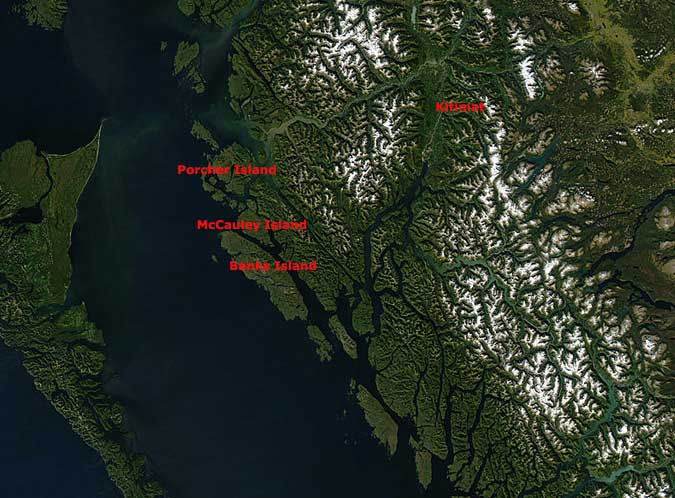![]() Shell Canada and its Asian partners have chosen TransCanada Corporation to design, build, own and operate the proposed natural gas pipline to Kitimat, now called the Coastal GasLink project.
Shell Canada and its Asian partners have chosen TransCanada Corporation to design, build, own and operate the proposed natural gas pipline to Kitimat, now called the Coastal GasLink project.
The estimated $4-billion pipeline will transport natural gas from the Montney gas-producing region near Dawson Creek, in northeastern British Columbia to the proposed natural gas export facility at Kitimat, BC.
The LNG Canada project is a joint venture led by Shell, with partners Korea Gas Corporation, Mitsubishi Corporation and PetroChina Company Limited.
A news release from TransCanada says “Shell and TransCanada are working toward the execution of definitive agreements on the Coastal GasLink project.”
In the release, Russ Girling, TransCanada president and CEO says:
Our team has the expertise to design, build and safely operate pipeline systems. We look forward to having open and meaningful discussions with Aboriginal communities and key stakeholder groups, including local residents, elected officials and the Government of British Columbia, where we will listen to feedback, build on the positive and seek to address any potential concerns. Coastal GasLink will add value to British Columbians, particularly Aboriginals and communities along the conceptual route, by creating real jobs, making direct investments in communities during construction and providing economic value for years to come.
TransCanada says the company has approximately 24,000 kilometres of pipelines in operation in western Canada including 240 kilometres of pipelines in service in northeast BC. Another 125 kilometres of proposed additions either already having received regulatory approval or currently undergoing regulatory review. These pipelines form an integral and growing part of TransCanada’s NOVA Gas Transmission Ltd. (NGTL) System, which brings natural gas from Alberta to British Columbia to a hub near Vanderhoof.
Girling said in the release:
TransCanada is a leading energy infrastructure company in North America, with a 60-year history of safe, efficient and reliable operation of our assets and a respect for the communities and environments where we operate. We appreciate the confidence that Shell and its partners have placed in us to build, own and operate this natural gas pipeline in British Columbia. We will work collaboratively with them, Aboriginals and other stakeholders as we launch into the initial phases of consultation and regulatory review.
Project parameters
In it’s release TransCanada describes the potential Coastal GasLink pipeline project this way:
- Receipt point: Near Dawson Creek, BC
- Delivery point: Proposed LNG Canada facility near Kitimat, BC
- Product: Natural gas from BC’s abundant Montney, Horn River and Cordova basins and elsewhere from the Western Canada Sedimentary Basin
- Length of route: Approximately 700 kilometres of large diameter pipe
- Initial pipeline capacity: In excess of 1.7 billion cubic feet of gas per day
- Anticipated jobs: Estimated 2000-2500 direct construction jobs over a 2- during construction 3 year construction period
Estimated cost: Detailed cost information will be developed following completion of project scoping and planning. The current estimate is approximately $4 billion - Regulatory process: Applications for required regulatory approvals are expected to be made through applicable BC provincial and Canadian federal processes
- Estimated in-service date: Toward the end of the decade, subject to regulatory and corporate approvals
Pipeline route
TransCanada says: “The final pipeline route will take into consideration Aboriginal and stakeholder input, the environment, archaeological and cultural values, land use compatibility, safety, constructability and economics.:

At this point there are two possible routes for the pipeline west of Vanderhoof. One route would be to follow the existing Pacific Northern Gas route that roughly parallels Highway 16. The second possibility is a cross-country route, which may lead to controversy. The Pacific Trails Pipeline, which would feed the KM LNG partners (Apache, Encana and EOG) goes across the mountains from Smithers. While the PTP project has the approval of most First Nations in the regions, Apache and PTP are still in negotiations with some Wet’suwet’en houses over portions where the pipeline would cross the traditional territory of the houses. The much more controversial Enbridge Northern Gateway pipeline follows a similar cross-country route and faces much stiffer opposition than the Pacific Trails Pipeline, due to the content of that pipeline, mainly diluted bitumen and because, critics say, Pacific Trails managed to secure the most geologically stable cross country route earlier in this decade when the pipeline was originally planned to import, not export, natural gas.
TransCanada says the Coast Gaslink pipeline will also have an interconnection with the existing Nova Gas (NGTL System and the liquid NIT) trading hub operated by TransCanada. The company says:
A proposed contractual extension of TransCanada’s NGTL System using capacity on the Coastal GasLink pipeline, to a point near the community of Vanderhoof, BC, will allow NGTL to offer delivery service to its shippers interested in gas transmission service to interconnecting natural gas pipelines serving the West Coast. NGTL expects to elicit interest in and commitments for such service through an open season process in late 2012.
That means that the Asian customers will not be just dependent on natural gas from northeast British Columbia. Instead the “molecules” of natural gas from Alberta will join the stream heading to Kitimat. “Open season” in the energy industry is an auction where potential customers or transporters bid for use the pipeline.
In the release Girling says:
The potential Coastal GasLink pipeline project will allow British Columbians, and all Canadians, to benefit from the responsible development of valuable natural gas resources and will provide access to new markets for that gas. The project will also create substantial employment opportunities for local, skilled labourers and businesses as part of our construction team,” concluded Girling. “We know the value and benefits that strong relationships in British Columbia can bring to this project and we look forward to deepening those ties as our extensive pipeline network grows to meet market and customer needs.
TransCanada Corp. is no stranger to controversy, the company is the main proponent of the Keystone XL pipeline from Alberta to the US Gulf Coast. Portions of that pipeline were put on hold by President Barack Obama pending further review and Keystone has become a hot issue in the current American presidential election.







